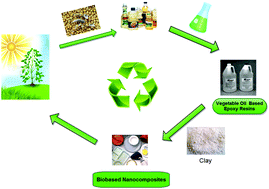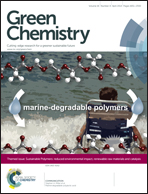Fabrication of bio-based epoxy–clay nanocomposites
Abstract
Epoxy–clay nanocomposites derived from renewable soybean oils and organo modified montmorillonite clay were prepared. Improved efficiency and performance were achieved through application of new, low viscosity, glycidyl esters of epoxidized fatty acids (EGS) as the epoxy monomer and 4-methyl-1,2-cyclohexanedicarboxylic anhydride as the comonomer. Tensile testing showed that 1 wt% of clay improved nanocomposite strength and modulus by 22% and 13%, respectively, compared to neat polymer. Tensile modulus could be increased up to 34% by nanocomposite clay without any sacrifice of strength. Three types of dispersion techniques, mechanical stirring, high speed shearing, and ultrasonication, were carried out to disperse the clay directly into the epoxy or anhydride portion of the thermoset system without the need of additional solvent. Dispersion of the clay particles into monomer was assessed by means of solubility parameters and optical and scanning electron microscopies, and quality of dispersion further confirmed by small angle X-ray scattering and transmission electron microscopy. Sonication dispersion of clay into the epoxy portion was needed to optimize the dispersion and exfoliation of clay and the higher mechanical and thermal strength of the nanocomposites. The nanocomposites’ morphologies were a mix of intercalated and exfoliated structures, dependent on the dispersion technique. The optimum tensile strength and glass transition temperatures of the nanocomposites were a function of clay concentration and dispersion morphology.


 Please wait while we load your content...
Please wait while we load your content...